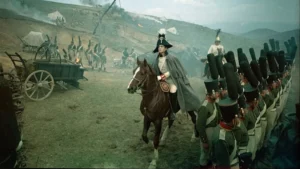We can mark the beginning of the modern era as the years 1648-1700, when most European states changed from disparate conglomerates of semi-independent feudal domains to solid units, with a strictly centralized bureaucratic apparatus. The predominant form of government became an absolutist monarchy, modeled after the France of Louis XIV. There were also a few exceptions. For example, in Great Britain and the Netherlands, a parliament consisting of representatives of the rich bourgeoisie and large latifundists took over the role of the all-powerful monarch. Poland, on the other hand, was unable to break free from feudal anarchy and paid the price of losing state sovereignty. Absolutist states, thanks to their more perfect establishment and technological superiority, established an era of European supremacy over the rest of the world, which lasted for almost 300 years.
One of the most important contributions of the emerging modern state was the separation of the civil and military components of society. In the second half of the 17th century, absolutist monarchs (or parliaments) decided to build professional armies subject to strict control. The sad experiences of the Thirty Years’ War, when undisciplined mercenaries looted more than fought, led them to this act. However, the construction of permanent armies could only be realized after the establishment of an absolutist government. Only a centrally controlled state as a monopoly tax collector could pay such an army and supply it with everything it needed. The army thus became completely dependent on the state and the monarch could treat it as private property. Since professional armies had to be constantly on alert, they were extremely expensive to maintain.
The officers of the new armies came almost exclusively from the ranks of the hereditary nobility, that is, from the social stratum that in the past formed the main opposition to unlimited monarchical power. Absolutist monarchs, however, managed to win her loyalty by establishing military schools, where young nobles were subjected to strict discipline and where, in addition to education in the field of military art, they were instilled that their primary duty was to serve the country and the king. The king rewarded them for their loyalty by confirming family privileges and granting various privileges. Professional officers formed a special social caste, whose prestige was soon so high that the uniform became the “work clothes” of all European rulers. In the Habsburg monarchy, this fashion was introduced by Emperor Joseph II.
The age of reason
Since no one was interested in gaining political or even religious hegemony in the 18th century, wars had a limited character in this “enlightened” era. Only partial goals were fought for: rich provinces, colonies, and lucrative trade routes. Wars were the exclusive business of monarchs and their professional armies. The rest of society didn’t care much about them. A good citizen was supposed to work and pay taxes. No one was allowed to disturb him during this activity, so he was not even required to serve in the army.
The need to keep in check the soldiers, among whom various adventurers and criminals appeared to a large extent, forced the generals to move the armies and fight in tight formations. Many of the men had a tendency to loot or desert and therefore had to be under constant surveillance by officers. The soldiers were not even allowed to find their own food and used the supplies stored in the rear fortresses. The rigidity of tactics led to the so-called attrition strategy. The dukes tried to cut off the enemy’s supply lines and starve the enemy army. At the same time, larger combat actions rarely took place, because the weapons, equipment, and training of soldiers cost too much to be wasted in a single battle.
In conducting such wars, the main advantage of each general was the sense of organization and coordination. Armies of the 18th century resembled machines that followed the orders of their commanders with mechanical precision. Traditional chivalric virtues such as honesty and individual courage were becoming an afterthought. For a pragmatic and rational commander, cunning was an important quality, as evidenced by the easiest way to win a war – to ambush an unsuspecting enemy and seize his supply depots before he could react. It is no wonder that the most successful duke of the 18th century was King Frederick II of Prussia, who brought this “art” to perfection. However, the chivalric spirit did not die out completely. The gallant behavior of rococo cavaliers towards women (even the unborn) was proverbial, and even enemy officers could always count on decent treatment. Captured private soldiers were no longer considered so much and they were most often included in the victorious army. However, it only applied in wars between civilized nations. Members of Asian armies (for example, Russian and Turkish) and irregular units (Croatian cops or North American Indians) could be incredibly cruel, and therefore they could not even expect better treatment from the enemy.
Although the 18th century saw several long European-wide conflicts (eg the War of the Austrian Succession 1740–1748 and the Seven Years’ War 1759–1763), their outcome was not decided on the battlefield. The party that ran out of money lost, and then the professional diplomats, as another product of the modern state, began to negotiate. Peace was concluded and some territories changed hands. The cause of disputes often remained unresolved. The basic purpose of every war – a more perfect peace – was thereby left unfulfilled, and disgruntled rulers threw themselves into new conflicts at the right opportunity. A typical example was Maria Theresa’s wars for Silesia.



